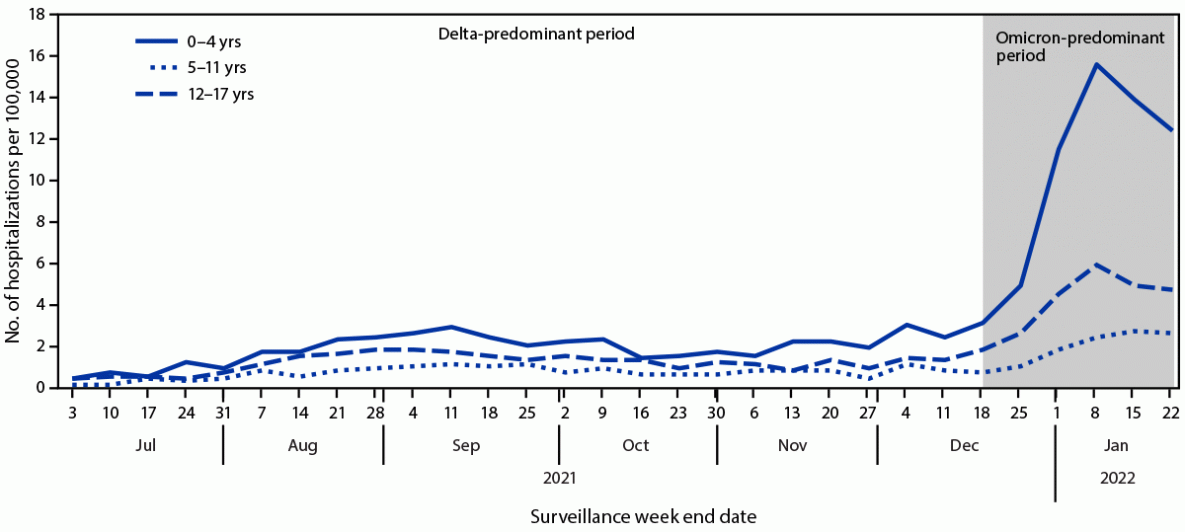Since the onset of the coronavirus disease 2019 (COVID-19) pandemic, several variants of the severe acute respiratory syndrome coronavirus 2 (SARS-CoV-2) have emerged.
Background
The recent Omicron variant was first reported in the United States on December 1, 2021; however, by December 25, 2021, Omicron quickly became the dominant circulating strain of SARS-CoV-2 throughout the U.S. Although COVID-19-related hospitalizations are more frequent among adults, they can also lead to severe outcomes in children and adolescents.
Several studies have indicated that COVID-19-associated hospitalizations in children and adolescents peaked during the Delta and Omicron dominant periods. The infection rates during the Omicron peak were significantly higher as compared to those that were reported during the Delta-peak. Therefore, the implementation of strategies for the prevention of COVID-19 in adolescents and children is important.
A new study published in the United States Centers for Disease Control and Prevention (CDC) Morbidity and Mortality Weekly Report analyzes data from the COVID-19-Associated Hospitalization Surveillance Network (COVID-NET) to determine COVID-19-associated hospitalizations among children between the ages of 0 and 11 years, as well as adolescents aged 12 to 17 years. The data used in this study was acquired from the Delta-dominant period between July 1, 2021, to December 18, 2021, and the Omicron-dominant period of December 19, 2021, to January 22, 2022, in the U.S.

Weekly COVID-19–associated hospitalization rates* among children and adolescents aged 0–17 years, by age group — COVID-NET, 14 states,† July 3, 2021–January 22, 2022
About the study
The current study involved the collection of data that serve as indicators of severe disease, which included length of hospital stay, use of invasive mechanical ventilation (IMV), intensive care unit (ICU) admission, and symptoms present during the admission of the patient. COVID-19-associated hospitalizations were confirmed by a positive SARS-CoV-2 reverse transcription-polymerase chain reaction (RT-PCR) or rapid antigen detection test.
Weekly hospitalization and ICU admission rates were calculated by dividing the total number of patients who were hospitalized by the population estimates within each age group. For adolescents, the hospitalization rate was calculated by the COVID-19 vaccination status, as this was the only age group included in the study that was eligible for vaccination. Thereafter, the proportions were compared between the Delta and Omicron predominance periods.
Study findings
Hospitalizations peaked in the weeks ending on September 11, 2021, and January 8, 2022, during the Delta and Omicron predominant periods, respectively, with the Omicron peak hospitalization rate being four times greater than those reported during the Delta period. The hospitalization rates among children aged 0 to 4 years were five times higher during the Omicron period as compared to the Delta period.
During December 2021, which is when both the Delta and Omicron variants were circulating, the rates of hospitalization were 23.5 and 3.8 per 100,000 among both unvaccinated and fully vaccinated adolescents. Notably, the proportion of fully vaccinated adolescents during the Delta period was lower as compared to the Omicron period, which can result in higher rates of hospitalization and ICU admissions. Furthermore, the rates of ICU requirement and IMV usage among hospitalized children and adolescents were lower during the Omicron period.
Conclusions
Taken together, the current study demonstrates that the emergence of the SARS-CoV-2 Delta and Omicron variants caused severe disease and hospitalizations among children and adolescents. Among adolescents, hospitalization was lower among the vaccinated individuals as compared to the unvaccinated individuals. Further research needs to be carried out to monitor COVID-19 associated hospitalization rates as more children and adolescents become fully vaccinated.
Limitations
Testing practices and test availability may have provided inaccurate data on hospitalizations. A second limitation of the current study was that the availability of detailed clinical data during the Omicron period was brief and initially coincided with the period of Delta circulation. Additionally, accounting for seasonality when comparing the predominance of both variants was not possible.
The number of children eligible for vaccination during the study was low, particularly because children between the ages of five and 11 years were not yet fully vaccinated group and, as a result, were not considered in the study. It should also be noted that the findings of the current study might not be generalizable to the entire United States.
Journal reference:
- Marks, K. J., Whitaker, M., Anglin, O., et al. (2022). Hospitalizations of Children and Adolescents with Laboratory-Confirmed COVID-19 — COVID-NET, 14 States, July 2021–January 2022. Morbidity and Mortality Weekly Report. doi:10.15585/mmwr.mm7107e4.